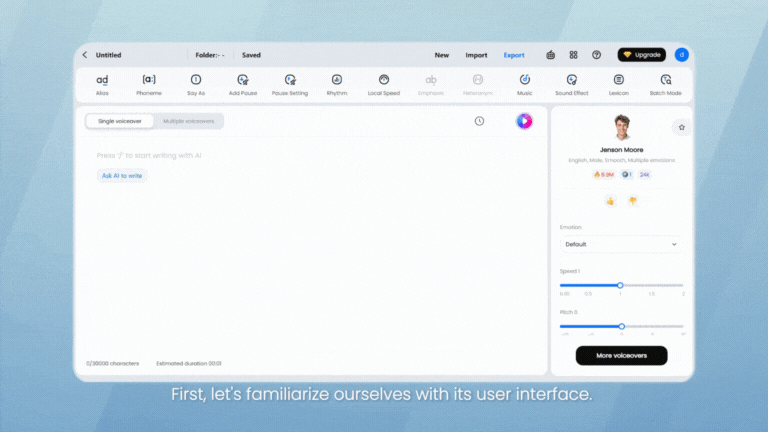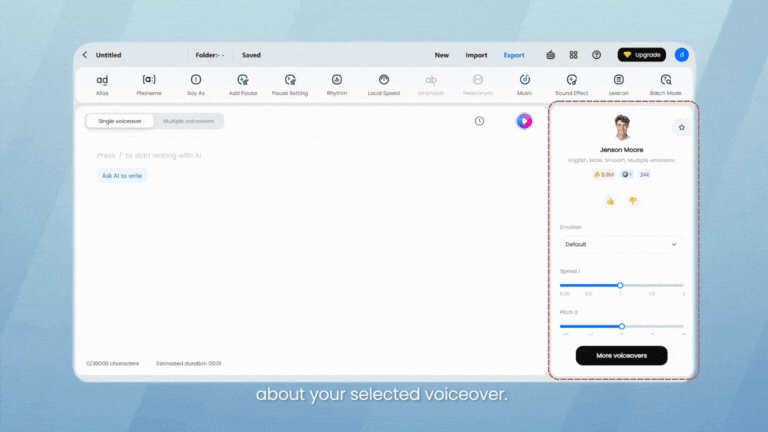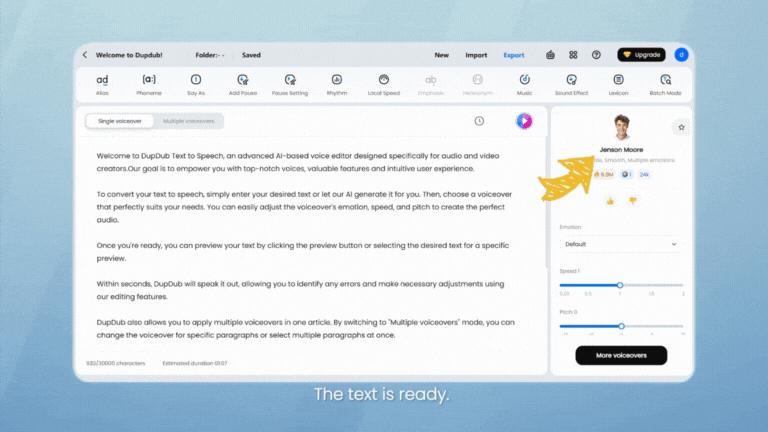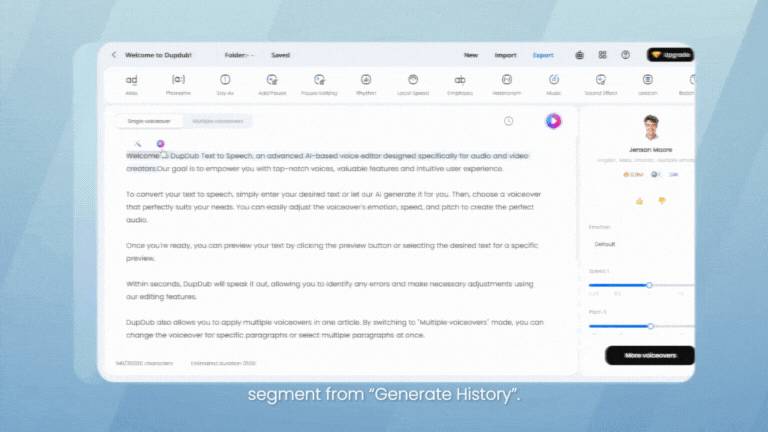Introduction
Need realistic AI voiceovers that don’t sound robotic? DupDub’s advanced TTS (text-to-speech) engine makes it easy to create human-like voiceovers in just minutes. Whether you’re creating videos, podcasts, online courses, or marketing content, this guide will show you how to generate natural-sounding audio step-by-step—no mic or recording studio needed.
Want to see it in action? Watch the full tutorial here on YouTube.
Step 1 – Understand the Workspace
Once you enter the AI Voiceover section in DupDub Studio, you’ll see a clean and intuitive interface:
-
Main editor: Where your script goes.
-
Toolbox: Fine-tuning tools for natural speech.
-
Voice settings: Preview and customize your selected voice.
Hover over each icon for helpful tips—it’s beginner-friendly by design.

Step 2 – Input or Import Your Script
There are multiple ways to load your content:
-
Type or paste your script directly.
-
Import TXT, DOCX, or PDF files.
-
Upload audio/video files to auto-transcribe.
-
Paste YouTube or TikTok links for subtitle generation.
If you’re starting from scratch, use DupDub’s built-in AI Writer to help brainstorm and write your script.

Step 3 – Select Your AI Voice
In the Voiceover Library, you can filter voices using the following criteria:
-
Language & Accent
-
Gender
-
Age
-
Quality (Standard, Premium, Ultra HD, etc.)
Alternatively, you can choose voices based on content type from the left-side panel, such as:
-
Animation Videos
-
E-commerce
-
Motivational
-
Reddit Story
-
Travel Guides
Click the play icon to preview voices instantly. After selecting a voice, you can set its emotional tone (e.g., Happy, Neutral, Sad) if that voice supports multiple emotions.
Need multiple speakers? Click "Multiple Voiceovers" to assign different voices to individual paragraphs.

Step 4 – Generate Voiceovers
You can:
-
Click "Generate Full Text" to synthesize the entire script.
-
Highlight a section and use "Generate Selected Text" to preview small parts.
All generated files are saved in "Generate History", where you can replay or download them.

Step 5 – Fine-Tune the Audio for a Human Feel
To make your voiceover sound more natural, use the Toolbox tools, which are categorized into three main areas:
1. Pronunciation Adjustment
-
Alias: Set alternative text for correct pronunciation.
-
Say As: Control how numbers, dates, or symbols are spoken.
-
Lexicon: Create a custom pronunciation dictionary.
2. Flow Modification
-
Add Pause / Pause Setting: Insert or manage pauses for better rhythm.
-
Local Speed: Adjust speed at specific text segments.
-
Batch Mode: Process multiple text blocks efficiently.
3. Expressive Control
-
Sound Effect / Music: Add background audio or effects to support tone.
-
Emphasis / Rhythm: (If enabled) Add stress or pacing to words.

These tools let you shape the delivery for clarity, emotion, and realism.
Step 6 – Export or Reuse the Audio
Once satisfied, download your audio in various formats, or import it into other DupDub tools like:
-
Video Editor
-
AI Avatar Generator
-
Subtitle Aligner
DupDub lets you keep your entire creative workflow in one place.

Final Tips for Better Voiceovers
-
Choose a voice style based on your content type (e.g., energetic for marketing, calm for tutorials).
-
Add strategic pauses to simulate real conversation.
-
Preview your final audio to ensure natural pacing and clarity.
-
Save frequently used voice and audio settings for reuse.
With DupDub, creating studio-quality AI voiceovers is fast, affordable, and scalable.
FAQs
-
Can I use DupDub’s AI voiceovers for commercial projects?
Yes, all paid plans include commercial use rights.
-
Does DupDub support multiple languages and accents?
Absolutely. DupDub offers voices in 90+ languages and regional accents.
-
How many voices can I use in a single project?
As many as you need. Just use the "Multiple Voiceovers" feature to assign different voices.
-
Can I fine-tune pronunciation for unique words or names?
Yes. Use the Pronunciation Editor in the Toolbox to define exact phonetics.
-
Will my generated voiceovers be saved for future use?
Yes. All generated files are saved in "Generate History" and can be downloaded anytime.

